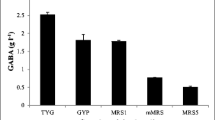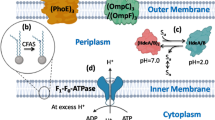Abstract
The toxic effects of 3-hydroxypropionic acid (3-HP) at high concentrations on cell growth and cellular metabolism are a great challenge to its commercial production. This study has examined and compared the toxic effects of 3-HP on cell growth with other similar weak acids, especially lactic acid, under various concentrations, temperatures and pH using Escherichia coli W as the test strain. 3-HP was approximately 4.4-times more toxic than lactic acid due to the 4.4-fold weaker acidity or 0.64 higher pKa value. The two acids presented no appreciable difference when the growth inhibition was correlated with the undissociated or protonated free acid concentration calculated by the Henderson-Hasselbalch equation. The growth inhibition by other small organic acids, such as acetic acid, pyruvic acid, propionic acid, 2-hydroxybutyric acid (2-HB) and 3-hydroxybutyric acid (3-HB), was also well correlated with their pKa values or protonated free acid concentrations. This study suggests that the growth inhibition by small weak acids is mainly caused by the socalled proton effect (rather than the anion effect), i.e., an increase in the intracellular proton concentration. An appropriate increase in the medium pH was suggested to alleviate the acid toxicity by reducing the free acid concentration in the culture medium.
Similar content being viewed by others
References
Royce, L. A., P. Liu, M. J. Stebbins, B. C. Hanson, and L. R. Jarboe (2013) The damaging effects of short chain fatty acids on Escherichia coli membrane. Appl. Microbiol. Biotechnol. 97: 8317–8327.
Gokarn, R. R., O. V. Selifonova, H. J. Jessen, S. J. Gort, T. Selmer, and W. Buckel (2007) 3-Hydroxypropionic acid and other organic compounds. U.S. Patent 7,186–541.
Lipscomb, T. W., M. L. Lipscomb, R. T. Gill, and M. D. Lynch (2013) Metabolic engineering of recombinant E. coli for the production of 3-hydroxypropionate. 1st ed., pp. 185–200. In: R. Patnaik (ed.). Engineering Complex Phenotypes in Industrial Strains. Wiley, Hoboken, NJ, USA.
Arasu, M. V., V. Kumar, S. Ashok, H. Song, C. Rathnasingh, H. J. Lee, D. Seung, and S. Park (2011) Isolation and characterization of the new Klebsiella pneumonia J2B strain showing improved growth characteristics with reduced lipopolysaccharide formation. Biotechnol. Bioproc. Eng. 16: 1134–1143.
Kumar, V., S. Ashok, and S. Park (2013) Recent advances in biological production of 3-hydroxypropionic acid. Biotech. Adv. 31: 945–961.
Lee, P., S. M. Raj, S. Zhou, S. Ashok, S. Edwadraja, and S. Park (2014) 3-Hydroxyisobutyrate dehydrogenase-I from Pseudomonas denitrificans ATCC 13867 degrades 3-hydroxypropionic acid. Biotechnol. Bioproc. Eng. 19: 1–7.
Roe, A. J., C. O’Byrne, D. McLaggan, and I. R. Booth (2002) Inhibition of Escherichia coli growth by acetic acid: A problem with methionine biosynthesis and homocysteine toxicity. Micorobiol. 148: 2215–2222.
Russell, J. B. and F. Diez-Gonzalez (1998) The effects of fermentation acids on bacterial growth. Adv. Microb. Physiol. 39: 205–234.
Van Maris, A. J., W. N. Konings, J. P. van Dijken, and J. T. Pronk (2004) Microbial export of lactic and 3-hydroxypropanoic acid: Implications for industrial fermentation processes. Metab. Eng. 6: 245–255.
Warnecke, T. and R. T. Gill (2005) Organic acid toxicity, tolerance, and production in Escherichia coli biorefining applications. Microb. Cell. Fact. 4: 25.
Mclaggan, D., J. Naprstek, E. T. Buurman, and W. Epstein (1994) Interdependence of K+ and glutamate accumulation during osmotic adaptation of Escherichia coli. Biol. Chem. 269: 1911–1917.
Archer, C. T., J. F. Kim, H. Jeong, J. H. Park, C. E. Vickers, S. Y. Lee, and L. K. Nielsen (2011) The genome sequence of E. coli W (ATCC 9637): Comparative genome analysis and an improved genome-scale reconstruction of E. coli. BMC Genom. doi:10.1186/1471-2164-12-9.
Sankaranarayanan, M., S. Ashok, and S. Park (2014) Production of 3-hydroxypropionic acid from glycerol by acid tolerant Escherichia coli. J. Ind. Microbiol. Biotechnol. 41: 1039–1050.
Wang, Y., T. Tian, J. Zhao, J. Wang, T. Yan, L. Xu, Z. Liu, E. Garza, A. Iverson, R. Manow, C. Finan, and S. Zhou, (2012) Homofermentative production of D-lactic acid from sucrose by a metabolically engineered Escherichia coli. Biotechnol. Lett. 34: 2069–2075.
Foster, J. W. (2001) Acid stress responses of Salmonella and E. coli: Survival mechanisms, regulation, and implications for pathogenesis. J. Microbiol. 39: 89–94.
Rathnasingh, C., S. M. Raj, Y. Lee, C. Catherine, S. Ashok, and S. Park (2012) Production of 3-hydroxypropionic acid via malonyl-CoA pathway using recombinant Escherichia coli strains. J. Biotech. 157: 633–640.
Kanjee, U. and W. A. Houry (2013) Mechanisms of acid resistance in Escherichia coli. Annu. Rev. Micobiol. 67: 65–81.
Marr, A. G. (1991) Growth rate of Escherichia coli. Microbiol. Rev. 55: 316–333.
Jin, D. J., C. Cagliero, and Y. N. Zhou (2012) Growth rate regulation in Escherichia coli. FEMS Microbiol. Rev. 36: 269–287.
Arnold, C. N., J. McElhanon, A. Lee, R. Leonhart, and D. A. Siegele (2001) Global analysis of Escherichia coli gene expression during the acetate-induced acid tolerance response. J. Bacteriol. 183: 2178–2186.
Blankenhorn, D., J. Phillips, and J. L. Slonczewski (1999) Acidand base-induced proteins during aerobic and anaerobic growth of Escherichia coli revealed by two-dimensional gel electrophoresis. J. Bacteriol. 181: 2209–2216.
Warnecke, T. E., M. D. Lynch, A. Karimpour-Fard, M. L. Lipscomb, P. Handke, T. Mills, C. J. Ramey, T. Hoang, and R. T. Gill (2010) Rapid dissection of a complex phenotype through genomic-scale mapping of fitness altering genes. Metab. Eng. 12: 241–250.
Han, M. and S. Y. Lee (2006) The Escherichia coli proteome: Past, present, and further prospects. Microbiol. Mol. Biol. Rev. 70: 362–439.
Klungsoeyr, L. and A. Endresen (1964) Intracellular pH effect upon phosphoglucose isomerase in Escherichia coli. Biochim. Biophys. Acta 92: 378–387.
Author information
Authors and Affiliations
Corresponding author
Rights and permissions
About this article
Cite this article
Chun, A.Y., Yunxiao, L., Ashok, S. et al. Elucidation of toxicity of organic acids inhibiting growth of Escherichia coli W. Biotechnol Bioproc E 19, 858–865 (2014). https://doi.org/10.1007/s12257-014-0420-y
Received:
Revised:
Accepted:
Published:
Issue Date:
DOI: https://doi.org/10.1007/s12257-014-0420-y




